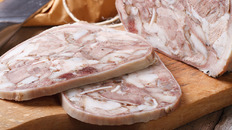Meats and Sausages
Traditional Head Cheese
| Meats | Metric | US |
|---|---|---|
| Pork head meat | 500 g | 1.10 lb |
| Pork back fat | 100 g | 0.22 lb |
| Pork tongues | 150 g | 0.33 lb |
| Pork skins | 250 g | 0.55 lb |
Ingredients per 1000g (1 kg) of meat
| Salt* | 18 g | 3 tsp |
| Pepper | 4.0 g | 2 tsp |
| Garlic | 3.5 g | 1 clove |
| Potato starch | 28 g | 1.0 oz |
Instructions
- The best quality head cheese is made from cured meats. Split heads and tongues are immersed in curing solution (salt and cure #1). The meats cured in this manner will have a beautiful red color and a longer shelf life. The fat does not contain myoglobin so it will remain white.
- Cure split heads, tongues, skins and back fat for 4 days in 16° Bé (60° SAL) cure solution.
- 16° Bé (60° SAL) cure solution is made by mixing 1.32 lb (598 g) salt, 4.2 oz (120 g) cure #1 and one gallon of water. Use 1/2 part (by weight) of meat to 1 part curing solution: 100 g of meat to 200 g (200 ml) curing solution.
- Wash all meats in cold water. Slow boil meats at around 200° F (93° C) until meats separate from bones. Remove from the stock and spread on the table. Save the stock. Remove meat from bones when still warm.
- Cut heat meat into 1/2-3/4” (12-15 mm) pieces.
- Cut tongues into into strips.
- Cut fat into 1” (25 mm) cubes.
- Cut skins finely or grind with 1/8” (3 mm) plate.
- Mix all meats together with spices and starch. Keep on mixing and start slowly adding meat stock (from boiling meats) until meat absorbs no more.
- Stuff into pork stomachs or beef bungs.
- Cook in water at 80° C (176° F) for about 90 minutes until meat reaches 68-70° C (154-158° F) internal temperature.
- Remove and partially cool in cold water. Place them on flat surface and press them down with boards with weights on them.
Notes
* do not use salt if meats were cured.


















